
Database System Concepts
7th Edition
ISBN: 9780078022159
Author: Abraham Silberschatz Professor, Henry F. Korth, S. Sudarshan
Publisher: McGraw-Hill Education
expand_more
expand_more
format_list_bulleted
Question
Solve all of them!

Transcribed Image Text:9. Divide-and-Conquer and Dynamic Programming. This question has been on a final exam.
(a) What does dynamic programming have in common with divide-and-conquer? What is a principal
difference between them?
(b) A recurrence for the number of combinations of m things out of n, ("), for n > 1 and 0< m < n:
n
if m = 0 or m = m
(") + () if 0 < m < n
Here is a recursive function comb taking two integer parameters n and m that returns (").
int comb( int n, int m ){
0 ) || ( m ==
if( ( m ==
n ) )
return 1;
else return( C( n-1,
m ) + C( n-1, m-1 ) );
}
Though this is not an optimization problem, convince yourself that the function computes many
subproblems over and over and that a dynamic programming approach can be applied to this
problem. Consider drawing the recursion tree to see this.
i. Modify the function comb to compute () using a top-down dynamic programming approach
using memoization (i.e., , a table). The table required here is two-dimensional, n x m.
ii. Solve the problem bottom-up with memoization.
Expert Solution
This question has been solved!
Explore an expertly crafted, step-by-step solution for a thorough understanding of key concepts.
Step by stepSolved in 2 steps

Knowledge Booster
Learn more about
Need a deep-dive on the concept behind this application? Look no further. Learn more about this topic, computer-science and related others by exploring similar questions and additional content below.Similar questions
- No plagarism please! Correct and detailed answer.arrow_forwardYou want to cut a rectangular pan of brownies, made up of n square-shaped brownies, but you can only make horizontal or vertical cuts. Assuming you can only make one cut at a time, how many cuts will you need to split the pan into n individual brownies? Use strong induction to prove your answer.arrow_forwardFind 2 recent articles on Artificial Intelligence and summarize the articles in own words.arrow_forward
- Question R .Full explain this question and text typing work only We should answer our question within 2 hours takes more time then we will reduce Rating Dont ignore this linearrow_forwardDesign a Turing machine that accepts L. L = {ww | w ԑ (a, b)+} Draw the tape and write down the instantaneous descriptions.arrow_forwardFill in the words to form a complete proof. Use the given equations in a complete proof of each theorem. Your proof should be expressed in complete English sentences.arrow_forward
arrow_back_ios
arrow_forward_ios
Recommended textbooks for you
 Database System ConceptsComputer ScienceISBN:9780078022159Author:Abraham Silberschatz Professor, Henry F. Korth, S. SudarshanPublisher:McGraw-Hill Education
Database System ConceptsComputer ScienceISBN:9780078022159Author:Abraham Silberschatz Professor, Henry F. Korth, S. SudarshanPublisher:McGraw-Hill Education Starting Out with Python (4th Edition)Computer ScienceISBN:9780134444321Author:Tony GaddisPublisher:PEARSON
Starting Out with Python (4th Edition)Computer ScienceISBN:9780134444321Author:Tony GaddisPublisher:PEARSON Digital Fundamentals (11th Edition)Computer ScienceISBN:9780132737968Author:Thomas L. FloydPublisher:PEARSON
Digital Fundamentals (11th Edition)Computer ScienceISBN:9780132737968Author:Thomas L. FloydPublisher:PEARSON C How to Program (8th Edition)Computer ScienceISBN:9780133976892Author:Paul J. Deitel, Harvey DeitelPublisher:PEARSON
C How to Program (8th Edition)Computer ScienceISBN:9780133976892Author:Paul J. Deitel, Harvey DeitelPublisher:PEARSON Database Systems: Design, Implementation, & Manag...Computer ScienceISBN:9781337627900Author:Carlos Coronel, Steven MorrisPublisher:Cengage Learning
Database Systems: Design, Implementation, & Manag...Computer ScienceISBN:9781337627900Author:Carlos Coronel, Steven MorrisPublisher:Cengage Learning Programmable Logic ControllersComputer ScienceISBN:9780073373843Author:Frank D. PetruzellaPublisher:McGraw-Hill Education
Programmable Logic ControllersComputer ScienceISBN:9780073373843Author:Frank D. PetruzellaPublisher:McGraw-Hill Education

Database System Concepts
Computer Science
ISBN:9780078022159
Author:Abraham Silberschatz Professor, Henry F. Korth, S. Sudarshan
Publisher:McGraw-Hill Education

Starting Out with Python (4th Edition)
Computer Science
ISBN:9780134444321
Author:Tony Gaddis
Publisher:PEARSON

Digital Fundamentals (11th Edition)
Computer Science
ISBN:9780132737968
Author:Thomas L. Floyd
Publisher:PEARSON

C How to Program (8th Edition)
Computer Science
ISBN:9780133976892
Author:Paul J. Deitel, Harvey Deitel
Publisher:PEARSON

Database Systems: Design, Implementation, & Manag...
Computer Science
ISBN:9781337627900
Author:Carlos Coronel, Steven Morris
Publisher:Cengage Learning

Programmable Logic Controllers
Computer Science
ISBN:9780073373843
Author:Frank D. Petruzella
Publisher:McGraw-Hill Education